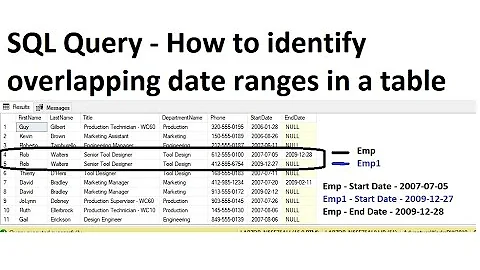Calculate missing date ranges and overlapping date ranges between two dates
Solution 1
It's a little variation of the function to flatten intersecting timespans in SQL Server:
It's one of the rare cases when cursor-based approach in SQL Server is faster the a set-based one:
CREATE FUNCTION mytable(@p_from DATETIME, @p_till DATETIME)
RETURNS @t TABLE
(
q_type VARCHAR(20) NOT NULL,
q_start DATETIME NOT NULL,
q_end DATETIME NOT NULL
)
AS
BEGIN
DECLARE @qs DATETIME
DECLARE @qe DATETIME
DECLARE @ms DATETIME
DECLARE @me DATETIME
DECLARE cr_span CURSOR FAST_FORWARD
FOR
SELECT startDate, endDate
FROM mytable
WHERE startDate BETWEEN @p_from AND @p_till
ORDER BY
startDate
OPEN cr_span
FETCH NEXT
FROM cr_span
INTO @qs, @qe
SET @ms = @qs
SET @me = @qe
WHILE @@FETCH_STATUS = 0
BEGIN
FETCH NEXT
FROM cr_span
INTO @qs, @qe
IF @qs > @me
BEGIN
INSERT
INTO @t
VALUES ('overlap', @ms, @me)
INSERT
INTO @t
VALUES ('gap', @me, @qs)
SET @ms = @qs
END
SET @me = CASE WHEN @qe > @me THEN @qe ELSE @me END
END
IF @ms IS NOT NULL
BEGIN
INSERT
INTO @t
VALUES (@ms, @me)
END
CLOSE cr_span
RETURN
END
GO
This function compresses each contiguous set of intersecting ranges into one range, and returns both the range and the following gap.
Solution 2
Without really understanding what problem you're trying to solve, here's my solution to some problem off the top of my head:
- Create table function (UDF) "all-dates" that would return all dates in a year.
- Convert your events to separate dates (one event row would become as many rows as there are days in it) by inner-joining events to the all-dates
where the date is between event's start and end dates... Retain original eventId. - Do an outer join of event-dates with all-dates (again) to find the gaps or misses.
- Join event-dates with themselves on
where dates are same but eventId is notto find overlaps.
Related videos on Youtube
Liam
Updated on April 16, 2022Comments
-
Liam about 2 years
I have the following set of dates (dd/MM/yyyy) matching events in my database:
eventId startDate endDate 1 02/05/2009 10/05/2009 2 08/05/2009 12/05/2009 3 10/05/2009 12/05/2009 4 21/05/2009 21/05/2009 5 25/05/2009 NULL 6 01/06/2009 03/06/2009
The events have a start and end date (times don't matter) and a NULL endDate means that the event is still in progress.
What I would like to determine is the ranges of dates between two arbitrary dates where there was a) no event and b) the events were overlapping.
So for an input date range of 01/04/2009 - 30/06/2009 I would expect to have the following results:
no event: 01/04/2009 - 01/05/2009 overlap : 08/05/2009 - 10/05/2009 overlap : 10/05/2009 - 12/05/2009 no event: 13/05/2009 - 20/05/2009 no event: 22/05/2009 - 24/05/2009 overlap : 01/06/2009 - 03/06/2009
Note that the two adjacent overlap ranges would be acceptable as one result.
Can anyone please help me with a SQL algorithm to generate this result set?
EDIT: The target platform database is SQL Server 2005. The dates are recorded as 10/05/2009 00:00:00, meaning that the event ended some time between 10/5/2009 00:00:00 and 10/5/2009 23:59:59. The same is true for the start dates. The input date range therefore also can be read as 01/04/2009 00:00:00 - 30/06/2009 23:59:59.
-
Ed Harper about 15 yearsOn which database platform(s) will you be running this query?
-





